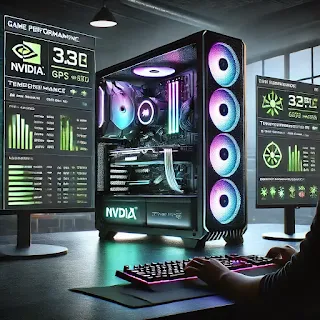If you're a gamer or content creator, squeezing every bit of performance from your graphics card can make all the difference. Whether you're rocking an Nvidia or AMD GPU, on a laptop or desktop, there are plenty of tweaks and optimizations you can make to boost your FPS and overall system efficiency. Let’s dive in!
1. Keep Your GPU Drivers Updated
Your GPU’s drivers are like its brain—keeping them updated ensures you get the best performance, compatibility, and bug fixes.
Nvidia Users: Download the latest drivers from Nvidia's official site.
AMD Users: Get the newest drivers from AMD's support page.
Tip: Use tools like GeForce Experience (Nvidia) or AMD Adrenalin Software to manage updates easily.
2. Overclocking: More Power, More Performance
Overclocking is pushing your GPU beyond its factory settings to gain extra performance.
Best Overclocking Tools:
MSI Afterburner – Works for both AMD and Nvidia GPUs. Download here.
ASUS GPU Tweak III – A great option for ASUS GPUs. Learn more.
How to Overclock Safely:
Increase the core clock and memory clock in small increments.
Test stability with tools like FurMark or 3DMark.
Monitor temperatures—don’t let them exceed 85°C under load.
3. Optimize Your In-Game Settings
Tweaking your graphics settings can lead to significant performance gains.
Lower shadow quality – High settings can be GPU-intensive.
Reduce anti-aliasing – FXAA or TAA is usually enough.
Lower texture resolution – Saves VRAM, especially for 4GB GPUs.
Enable DLSS (Nvidia) or FSR (AMD) – These AI-based upscaling techniques boost FPS.
4. Enable Hardware-Accelerated GPU Scheduling
Windows 10 and 11 have a built-in feature that reduces GPU latency and boosts performance.
How to Enable It:
Go to Settings > System > Display.
Scroll down to Graphics settings.
Turn on Hardware-accelerated GPU scheduling.
5. Keep Your GPU (Nvidia / AMD) Cool
Overheating can throttle performance and shorten your GPU’s lifespan.
Clean your GPU fans – Dust buildup can clog airflow.
Improve case airflow – Add more fans if needed.
Laptop Users: Use a cooling pad for better heat dissipation.
Check thermal paste – Replacing old thermal paste can reduce temps significantly.
6. Use Nvidia and AMD Control Panel Tweaks
Both Nvidia and AMD offer software optimizations to fine-tune performance.
Nvidia Control Panel Tweaks:
Go to Manage 3D settings and set Power Management Mode to Prefer Maximum Performance.
Enable G-Sync for smoother gameplay.
AMD Radeon Software Tweaks:
Set Radeon Boost to dynamically adjust resolution for better FPS.
Enable Radeon Image Sharpening for clearer visuals with minimal performance loss.
7. Adjust Windows Power Settings
Windows can throttle your GPU’s performance if it’s set to power-saving mode.
How to Change It:
Open Control Panel > Power Options.
Select High Performance.
8. Monitor Your GPU Performance
Using monitoring tools can help you track performance and spot issues.
GPU-Z – Detailed GPU stats (Download here).
HWMonitor – Monitors temps and voltages (Download here).
MSI Afterburner – Also works as a real-time monitor.
9. Enable Resizable BAR (AMD) or Smart Access Memory (Nvidia)
This feature allows your CPU to access your GPU’s memory more efficiently, improving performance.
How to Enable:
Go to your BIOS settings (press DEL or F2 at startup).
Look for Resizable BAR (Nvidia) or Smart Access Memory (AMD) and enable it.
Save and exit BIOS.
10. Join the Community for More Tips
The PC gaming and tech community is full of enthusiasts who share their optimization tips and tricks.
Reddit Communities:
Tech Forums:
Final Thoughts
By following these tips, you’ll be able to maximize your GPU’s performance and get the most out of your gaming or creative workflows. Whether it’s updating drivers, tweaking settings, or improving cooling, every little bit helps.
Got a question or a tip to share? Drop it in the comments below!

Comments
Post a Comment